Understanding your car’s health has become significantly easier with the advent of OBD2 Bluetooth adapters. These handy devices allow you to wirelessly connect your smartphone or tablet to your car’s onboard diagnostic system. If you’re looking to read diagnostic trouble Code Obd2 Bluetooth enabled tools are a fantastic entry point. This guide will walk you through the straightforward process of connecting your OBD2 Bluetooth adapter, so you can start monitoring your vehicle’s performance and diagnosing potential issues right from your mobile device.
First, ensure you have an OBDII ELM327 compatible adapter that specifically features Bluetooth connectivity. These adapters are readily available online and at auto parts stores.
Next, locate your car’s OBDII port. This is usually found under the dashboard on the driver’s side, but the exact location can vary depending on your car’s make and model. Consult your vehicle’s owner’s manual if you’re unsure.
Once you’ve located the port, plug your OBD2 Bluetooth adapter firmly into the socket.
With the adapter plugged in, you’ll need to power it on. Typically, this happens automatically when you turn your car’s ignition to the “ON” position (you don’t necessarily need to start the engine, but ensure the car’s electrical system is active). Some adapters may have a power button on the device itself, so if you don’t see any lights or indication of power, check for a button and press it.
Now that your adapter is physically connected and powered on, it’s time to establish a Bluetooth connection with your smartphone or tablet.
Step #1: Bluetooth Pairing with Your Android Device
If you’ve previously paired Bluetooth devices with your phone, this process will feel familiar. Note: The exact steps might slightly vary depending on your Android version.
- Access Bluetooth Settings: Open your Android device’s settings menu. Look for the “Bluetooth” section, usually found under “Connections” or “Wireless & Networks.”
- Enable Bluetooth: Turn Bluetooth on. Your device will begin scanning for nearby Bluetooth devices.
- Locate Your OBD2 Adapter: Wait for the list of available devices to populate. Your OBD2 adapter should appear in the list. It’s commonly named “OBDII,” “obd2,” or something similar like “ELM327.” If it’s a branded adapter, it might show up under its brand name, such as “Viecar” or “VLink.” Important: Do not look for your car’s brand name or something generic like “MY CAR” – the adapter’s name will be related to its function or brand.
- Pair with the Adapter: Tap on your OBD2 adapter’s name in the list to initiate pairing. You’ll likely be prompted to enter a PIN code.
- Enter the PIN Code: If you’re unsure of the PIN, consult the documentation that came with your OBD2 adapter. Common PIN codes are “1234“, “0000“, “7890“, or “1111“. Enter the PIN and confirm the pairing.
Once successfully paired, your OBD2 adapter will be listed under paired Bluetooth devices on your phone.
Step #2: Selecting Your Adapter in a Car Scanner App
With the Bluetooth connection established, you’ll need a car scanner app to interpret the data from your OBD2 adapter. Popular apps include Car Scanner, Torque Pro, OBD Fusion, and many others available on app stores. For this guide, we’ll focus on using the “Car Scanner” app as referenced in the original instructions.
- Open Car Scanner App: Launch the Car Scanner application on your phone or tablet.
- Access Settings: Look for a “Settings” or “Configuration” icon within the app, usually represented by a gear icon, often located in the top-right corner of the screen.
- Navigate to Adapter/Connection Settings: Within the settings menu, find the section related to adapter or connection settings. In older versions of Car Scanner, this might be labeled “Connection,” while newer versions may simply say “Adapter.”
- Choose Connection Type: Select “Bluetooth” as your connection type. This tells the app to communicate with your adapter via Bluetooth.
- Select Device: Tap on an option like “Select device” or “Choose Bluetooth Device.” The app will display a list of available Bluetooth devices.
- Select Your OBD2 Adapter: From the list, tap on the name of your OBD2 Bluetooth adapter that you previously paired with your phone. This links the app to your specific adapter.
After selecting your adapter, navigate back to the main screen of the Car Scanner app. You should now see a prominent “Connect” button, often green and large.
Connecting and Diagnosing
Tap the “Connect” button. The app will now attempt to establish a connection with your OBD2 adapter and, through it, to your car’s diagnostic system. Once connected, you’ll be able to access a wealth of information, including reading diagnostic trouble codes (DTCs), monitoring engine performance parameters in real-time, and much more, depending on the capabilities of your adapter and the features of your chosen car scanner app.
For subsequent uses, after the initial pairing and setup, the process becomes even simpler. Just ensure your OBD2 adapter is plugged in and powered on, open your car scanner app, and tap the “Connect” button. You’ll be quickly linked to your car’s data, empowering you to understand and address any potential issues signaled by a code obd2 bluetooth system can reveal.
